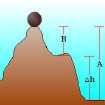Chapter 10
Chapter 11
Energy
When work is done on an object, the "energy" of the
object is changed.
Key Terms
- kinetic energy is the energy due to the motion of an object
- potential energy is energy stored in an object because of its
state or position
- work energy theorem states that the change in the kinetic energy
of an object is equal to the net work done on it.
- gravitational potential energy depends on the weight of the body
and its separation from Earth
- reference level set equal to zero at the ground or floor level
- The law of conservation states that within a clossed, isolated
system, energy can change form, but the total amount of energy is constant
- mechanical energy is the sum of potential and kinetic energy
- elastic collision- is when the potential energy is completely converted back
into kinetic energy after the collision
- in elastic collision- happens during a collision some kinetic energy is changed
into forms
Key Equations
The kinetic energy of an object is given by:
KE=1/2mvsquared
where m is the mass of the object and v is the velocity
E=KE+PE is the total energy E, as the sum of the kinetic
energy and potential energy
By using the equation for motion with constant acceleration, we find velocity
at any height,vf is given by
vfsquared=vi squared+2gh
In this equation, h is the vertical distance measured from the launching height of the
object multiplying each term in this equation by 1/2m gives the kinetic energy, 1/2mf squred, at
any height, h



1/2mvfsqured=1/2mvfsqured+mgh
But E=KE+PE,so the gravitiational potenial energy is given by
PE=mgh



Law of conservation of energy is:
KEi+PEi=KEf+PEf



Mechanical energy is the sum of potential and kinetic energy.
Problem: Suppose the ball weight of 10.0N. If it is at rest on a shelf 2.00m above Earth's surface, it has no kinetic energy, but
a potential energy related to Earth's surface given by
Solution:
PE=mgh
=(10.0N)(2.00m)=20.0J.
Problem:
If the ball rolls from the shelf, there are no force on the ball other than gravitational orce on Earth, so the ball falls. When it is 1.00m
above Earth's surface,its potential energy is
solution:
PE=mgh
=(10.0)(1.00m)=10.0J.
Problem:
If the ball has lost half its potential energy falling 1.00m. The ball is moving, however, and has gained kinetic energy. The change in kinetic energy
can be found from the work-energy theorem
Solution:
W=KE
=KEF-KEi
=KEf.
The work done on the falling ball by the gravitational force,mg is given by W=Fd
Summary of the Chapter
Kinetic energy is the energy an object has because of its motion.
Potential energy is the energy an object has because of its position, shape and form.
According to the work- energy theroem, the work done on anobject by the net force acting on it is equal to the change in kinetic energy
of the body.
Gravitational potential energy depends on the weight of the body and its separation from Earth: PE=mgh.
The sum of the kinetic amd potenial energies of a system is called the mechanical energy.
According to the law of conservation of energy, the total energy of a closed, isolated system is constant. Within the system, energy can change form
but the total energy does not change.
In an elastic collision, the total momentum and kinetic energy of the system is the same before and after the collision.
In an inelastic collision, momentum is conserved; total kinetic energy is decreased.
LINKS
id.mind.net
en.wikipedia.org
en.wikipedia.org
scienceworld.wolfram.com
References
Symmetry-August 2005 The Compact Linear Collider By Elizabeth Clement
Wjkipedia The Free Encyclopedia
Physics Today December 2004
Fusion Energy Sciences American Physical Society 2003
Popular Mechanices Fly This Plane November 2005
Merrill Physics: Principles and Problems Authors: Paul W. Zitzewitz and Robert F. Neff











